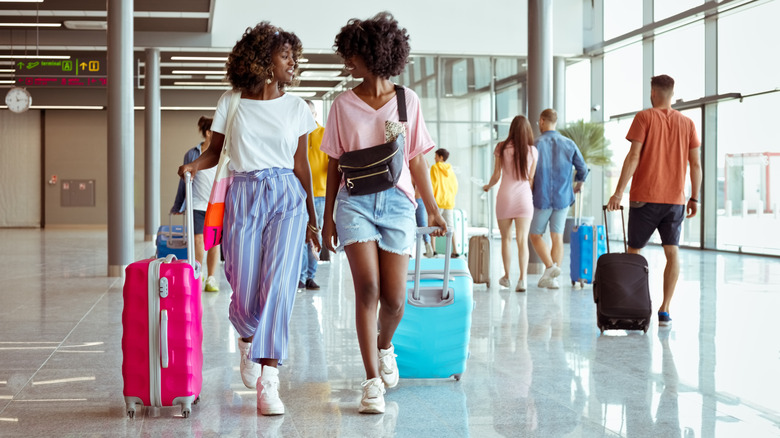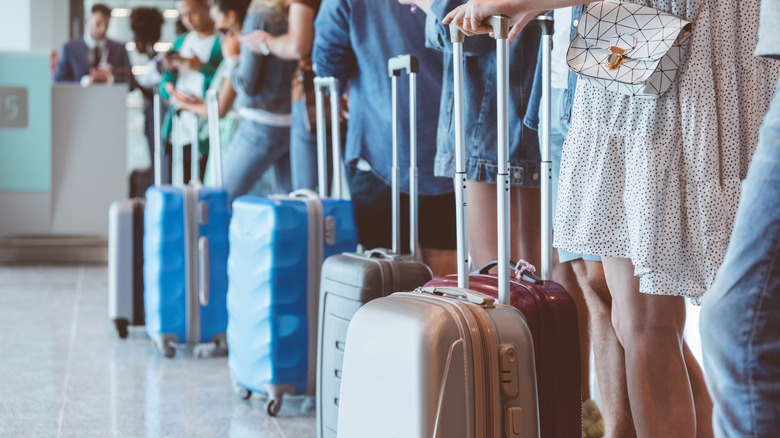Airline Dress Codes Are Stricter Than You Think
What do Billy Joe Armstrong, Olivia Culpo, and Aubrey O'Day have in common? Aside from their celebrity status, all three have had run-ins with airlines over their outfits. The Green Day frontman got booted for wearing his pants too low, the Miss Universe 2012 winner got flak for rocking athleisure (her midriff was showing), and the former Danity Kane singer was told to change her top because it had profanity written on it. Yup, if airlines aren't cutting these stars any slack for breaking dress codes, you can bet they're not letting the rest of us off the hook. And despite not explicitly broadcasting their dress codes, airlines have stricter standards than you might think.
When traveling, we tend to think that the world is our runway. And usually, it is — perhaps except for that one clothing mistake you don't want to make in Las Vegas or that sporting that one no-go item when you're traveling in the Caribbean. Otherwise, you're generally free to dress however you please. However, the rules change when you board planes. Airlines expect you to dress appropriately, and some even have specific dress codes in their contracts of carriage — you know, that fine print you totally read when booking a flight. And sure, some of the language in these contracts might be a bit vague, but the general expectation airlines have for passengers is crystal clear: dress decently up in the air or risk getting denied boarding entirely.
Some Airlines kick passengers for violating dress codes
You've probably heard plenty of stories about passengers being called out for their in-flight fashion choices. Take "American Ninja Warrior" contestant Maggi Thorne, who, in September 2023, was scolded by a Southwest Airlines flight attendant for wearing a crop top and joggers — standard athletic gear for her as an athlete. "She came over and asked me about my outfit and said that she thought it was too revealing and not appropriate for the airline," she told Business Insider.
But here's the kicker: the flight attendant was just doing her job. Southwest Airlines' contract of carriage states it may "refuse to transport" passengers wearing "clothes that are lewd, obscene, or patently offensive." And while a crop top might seem harmless to many, the airline says it has "sole discretion" over what it deems inappropriate. The same goes for Delta, who will refuse any passenger whose clothing "creates an unreasonable risk of offense or annoyance to other passengers." Even budget airlines like Spirit employ a similar rule, barring passengers from wearing attire that's "lewd, obscene, or offensive in nature."
Hawaiian Airlines gets even more specific, requiring passengers to wear clothing that fully covers their torso. "Tank tops, tube tops, and halter tops are allowed," its contract reads. However, speedos and bikini bottoms aren't. And so the next time you're planning your travel outfit, remember that airlines have their own version of fashion police — and they won't hesitate to enforce their rules at 30,000 feet.
Dress codes exist for a reason
Those airline dress codes can feel restrictive, but they're not just there to cramp your style. Mary Jo Manzanares, a travel writer who also worked as a flight attendant for over three decades, told CNN that dress codes exist to prevent any in-flight ruckus that may arise from passengers' clothing choices. That's why some folks get policed and are either barred from boarding or asked to change outfits before takeoff. "You've got to make your priority resolving things on the ground, making sure that there is no aggression," she explained. "When you go to 30,000 feet, you may [have] passenger conversation or banter or inappropriate comments between passengers, add in a little alcohol, and you may be making an unscheduled landing. And no one wants that."
Let's not forget, these dress codes are also about safety. Just like there are some shoes you should not wear on planes, the rules regarding clothing are for your own good. "Passengers cannot come onboard bare-footed because they might cut their foot on debris on the ground and require medical attention," Intan, a former flight attendant with Jetstar International Airways and Qatar Airways, shared with Matador Network. "Every rule is to ensure customers' safety."
Besides, you'd want to cover up for flights anyway. Planes are infamous for their inconsistent cabin temperatures, and the last thing you need is to be shivering because you didn't dress appropriately. If not for the dress code, do it for your own comfort.

